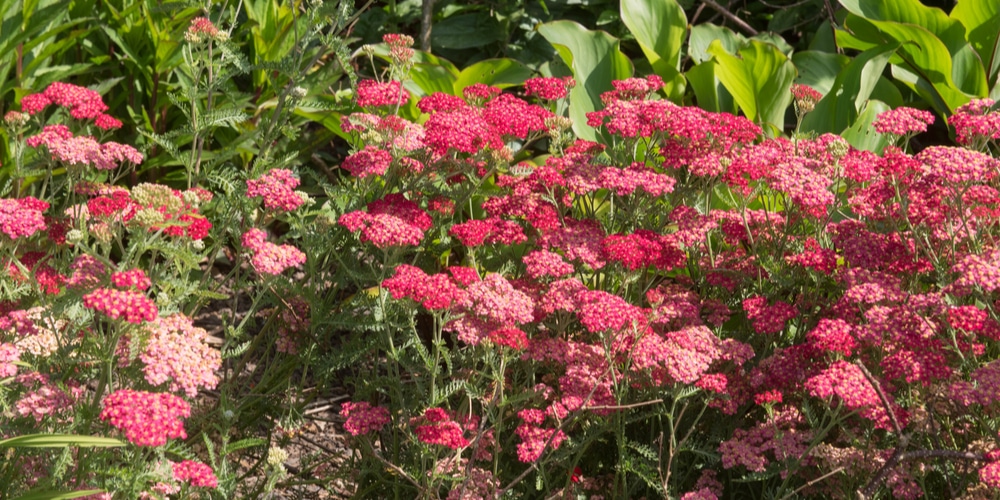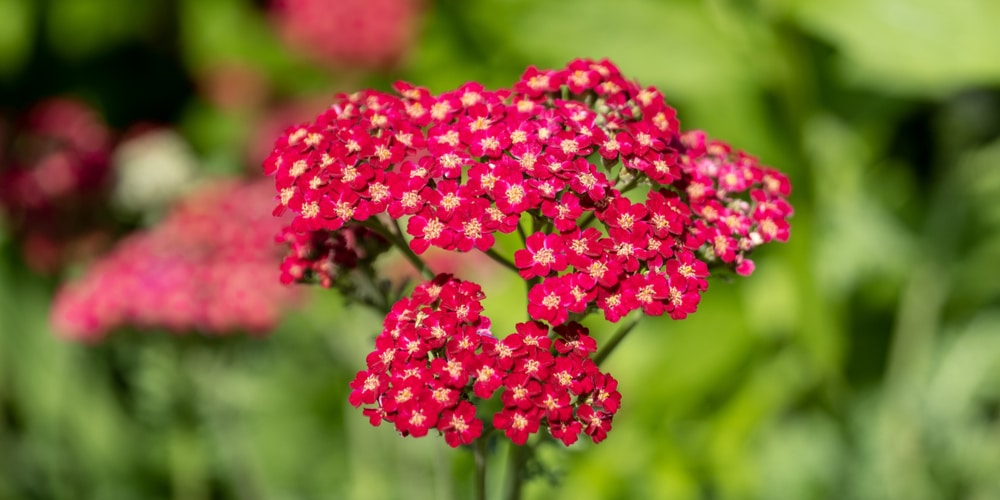If you’re lucky enough to have Achillea millefolium ‘Red Velvet’ in your garden, you know that this is one plant that definitely lives up to its name. With deep red flowers that appear almost velvety, it’s no wonder this variety is a favorite among gardeners.
With its mat-forming habit and drought tolerance, ‘Red Velvet’ is also excellent for groundcover or rock gardens.
Of course, like all plants, Red Velvet does require some care and attention to keep it looking its best. This article will go over everything you need to know about Achillea millefolium care, from watering to fertilizing to pruning. By following these simple tips, you can keep your plant looking gorgeous all season long!

| Botanical Name | Achillea Millefolium |
| Common Name | Red Velvet Yarrow |
| Plant Type | Perennial |
| Flower Color | Deep red |
| Size When Mature | 24 inches |
| Bloom Time | Early summer |
| Sun Requirements | Full sun, partial shade |
| USDA Hardiness Zones | 3 – 9a |
| Soil PH Range | 5.5 – 6.8 |
| Soil Type | Acidic, well-draining, sandy, moist soil |
| Water Needs | Medium |
| Native Area | North America |
What You Need to Know About Achillea Millefolium Red Velvet
Achillea millefolium Red Velvet is a perennial plant that typically grows about 2 feet tall. Its foliage is topped with delicate, fern-like leaves, perfectly paired with its small, yet vibrant red flowers.
Additionally, its fragrant flowers make it a popular choice for cut flower arrangements. Its attractive and finely divided foliage makes it a great addition to any garden bed or border, with flowers blooming gracefully during the summer months.
This variety is also an excellent choice for groundcover or rock gardens. It has a mat-forming habit and is tolerant of drought, making it perfect for hot, dry areas of the garden.
How to Care for Achillea Millefolium Red Velvet
Here’s everything you need to know about growing and caring for a thriving Achillea millefolium Red Velvet plant:
Light
The Achillea millefolium Red Velvet is a stunning addition to any garden, boasting beautiful deep red flowers that provide a dramatic pop of color. But while this plant is easy to grow, it does require some care and attention to thrive.
Similar to all other Achillea varieties, this gorgeous and butterfly-friendly plant thrives when exposed to at least six hours of sunlight. While this plant may do good in some shade, it may produce fewer and less vibrant blooms.
If your Achillea is not getting enough sunlight, you may notice that the plant becomes leggy. It’ll have longer stems and fewer leaves, and the blooms will be smaller. If this is the case, simply move your plant to a sunnier location. When grown in pots, it prefers to be in a south-facing window.
Water and Soil Needs
This hardy perennial needs well-drained soil to thrive. When watering, be sure to check the soil first. If it’s dry to the touch, give your plant a good drink. Ensure not to overwater, as this can lead to root rot.
In terms of soil, Achillea millefolium Red Velvet does best in sandy or gravelly soils. If your garden’s soil is heavy or clay-like, you may want to consider planting your Red Velvet in a raised bed or potting it up. This will help ensure that the plant has the well-drained soil it needs to thrive.
Although Red Velvet can thrive even in poor soil conditions, it does best in sandy soil with a pH between 5.5 to 6.8.
Temperature Requirements
This perennial is winter hardy and can tolerate temperatures as low as -40 degrees Fahrenheit. It can grow in USDA zones 3-9a, making it a versatile plant that can be grown in a wide range of climates.
For those situated in areas with severe temperature changes, mulching the plant in fall will help protect the roots over winter and provide some extra insulation.
Fertilizer
This is a tough plant that doesn’t require much fertilization. In fact, the best fertilizer for Achillea millefolium Red Velvet is compost. Adding a few handfuls of compost to the soil around your plant in early spring will give it a nutrient boost that will last all season.
Common Diseases
This variety of Achillea is relatively resistant to both pests and diseases. However, it can be susceptible to root rot if overwatered or planted in poorly drained soil. Additionally, slugs and snails may enjoy munching on the leaves, so be sure to keep an eye out for these pests. Taking out the slugs by hand is the best way to get rid of them.
Additionally, you can also get a bag of diatomaceous earth and sprinkle it around the base of your plant. This will help deter pests and keep the area around your plant clean and free of debris.
Achillea Millefolium Red Velvet Propagation
This plant’s natural and stunning color makes it a great addition to any garden. To add more of these beautiful blooms to your garden, Achillea millefolium Red Velvet can be easily propagated from seed, cuttings, or divisions.
Start them indoors in late winter or early spring to propagate from seed. Sow the seeds on the surface of the moistened seed-starting mix and press them lightly into the soil. Keep the soil moist but not soggy, as too much water can lead to fungal growth.
Once the seedlings have sprouted, thin them out so that there is only one per pot. Once they’ve grown to be about 4 inches tall, they can be transplanted outdoors.
To propagate from cuttings, take 4-6 inch stem cuttings in late spring or early summer. Remove the bottom leaves and dip the cut end in a rooting hormone. Then, plant the cutting in moistened perlite or sand. Be sure to keep the rooting medium moist but not soggy.
Once the cutting has rooted, it can be transplanted into a pot or garden bed.
Propagating from divisions is best done in early spring, just as new growth is beginning to appear. Dig up the entire plant and carefully divide it into smaller sections, making sure that each section has several roots attached. Replant the divisions immediately, and water them well.
Related Article: Achillea Terracotta

